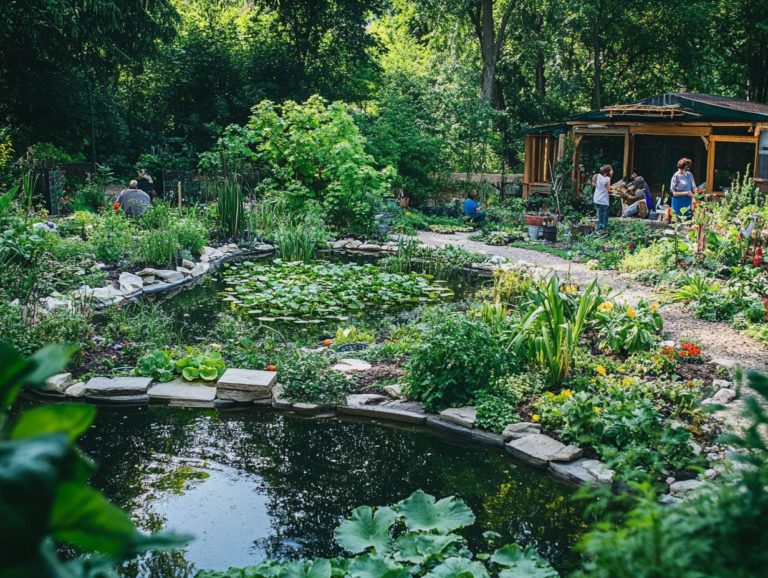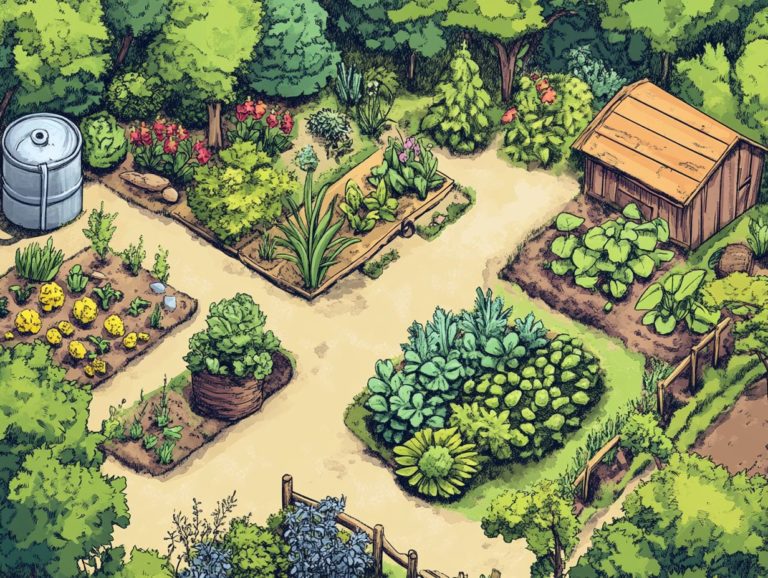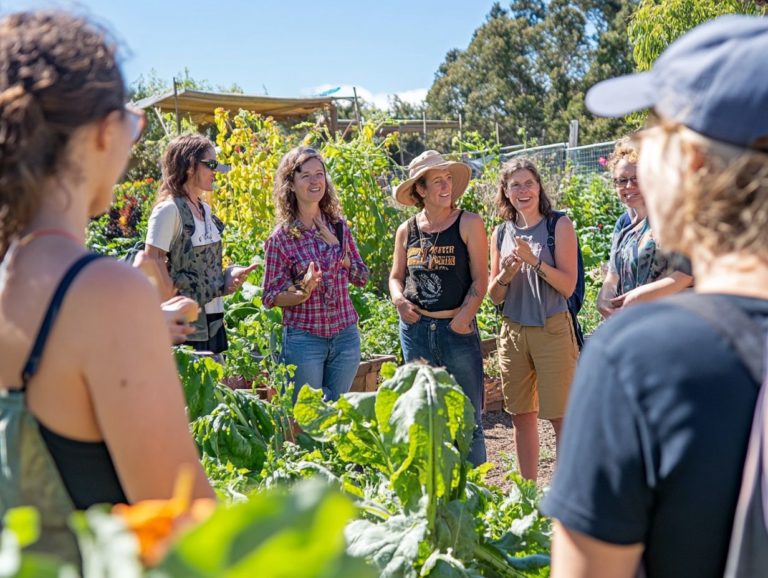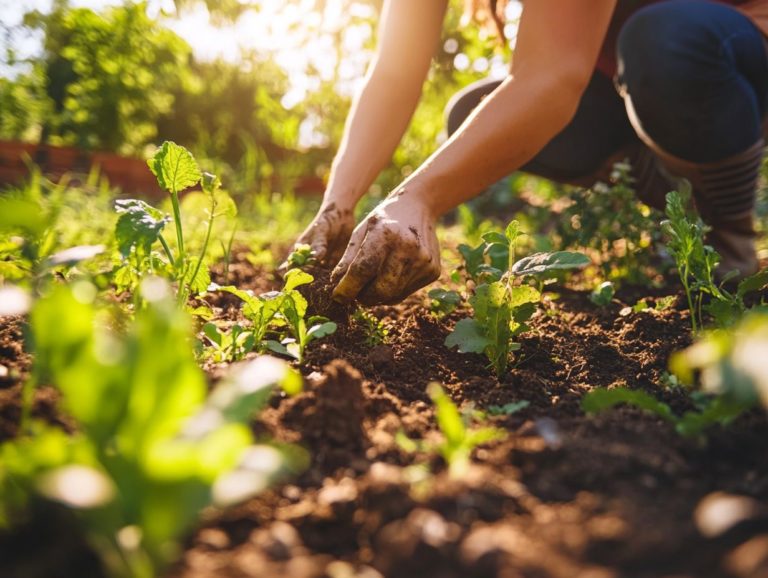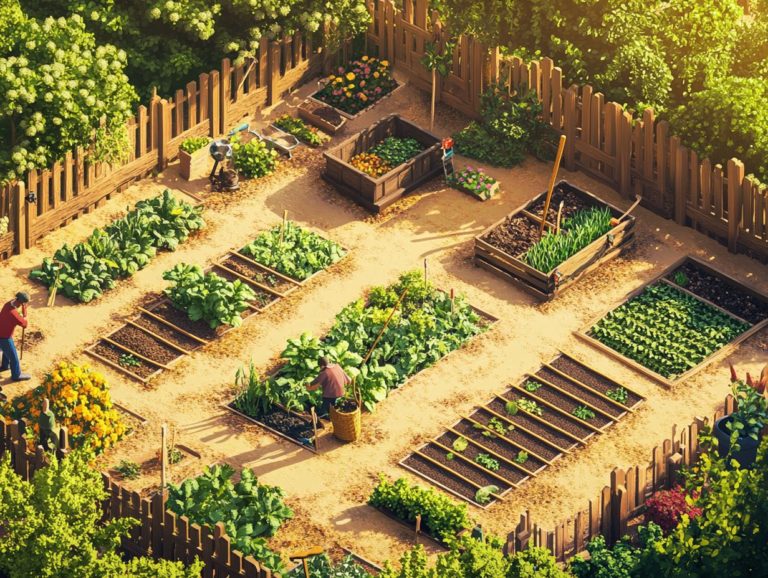64. 10 Fun Activities for Permaculture Groups
Permaculture transcends mere sustainable gardening; it embodies a lifestyle that nurtures community, creativity, and a deep sense of environmental stewardship through creative teaching techniques and nature play.
This article delves into ten engaging activities tailor-made for permaculture groups. These activities range from hands-on gardening and composting workshops to wildcrafting adventures and eco-friendly crafts!
Whether you seek to enhance your sustainability skills or connect with kindred spirits, you ll discover practical tips and insights that empower you to create a positive impact in your community.
Immerse yourself and uncover inspiration for your next permaculture gathering, perhaps inspired by seasonal festivals or the Zero Waste Challenge!
Contents
- Key Takeaways:
- 1. Gardening and Farming
- 2. Composting Workshop
- 3. Seed Saving and Plant Propagation
- 4. Building with Natural Materials
- 5. Cooking and Preserving Food
- 6. Wildcrafting and Foraging
- 7. Creating a Permaculture Design
- 8. Nature Walks and Observation
- 9. Community Building and Skill Sharing
- 10. Eco-Friendly Crafts and DIY Projects
- What Is Permaculture and Why Is It Important?
- How Can Permaculture Benefit the Environment and Society?
- What Are the Key Principles of Permaculture?
- How Can Permaculture Be Applied in Urban Areas?
- What Are Some Common Challenges in Permaculture and How Can They Be Overcome?
- How Can Permaculture Groups Make a Positive Impact in Their Community?
- What Are Some Tips for Hosting a Successful Permaculture Activity?
- Frequently Asked Questions
- What are some fun activities for permaculture groups?
- How can community gardening benefit a permaculture group?
- What is seed swapping and why is it a great activity for permaculture groups?
- Why are composting workshops important for permaculture groups?
- What can nature walks offer for permaculture groups?
- How can permaculture groups incorporate fun activities into their meetings?
Key Takeaways:
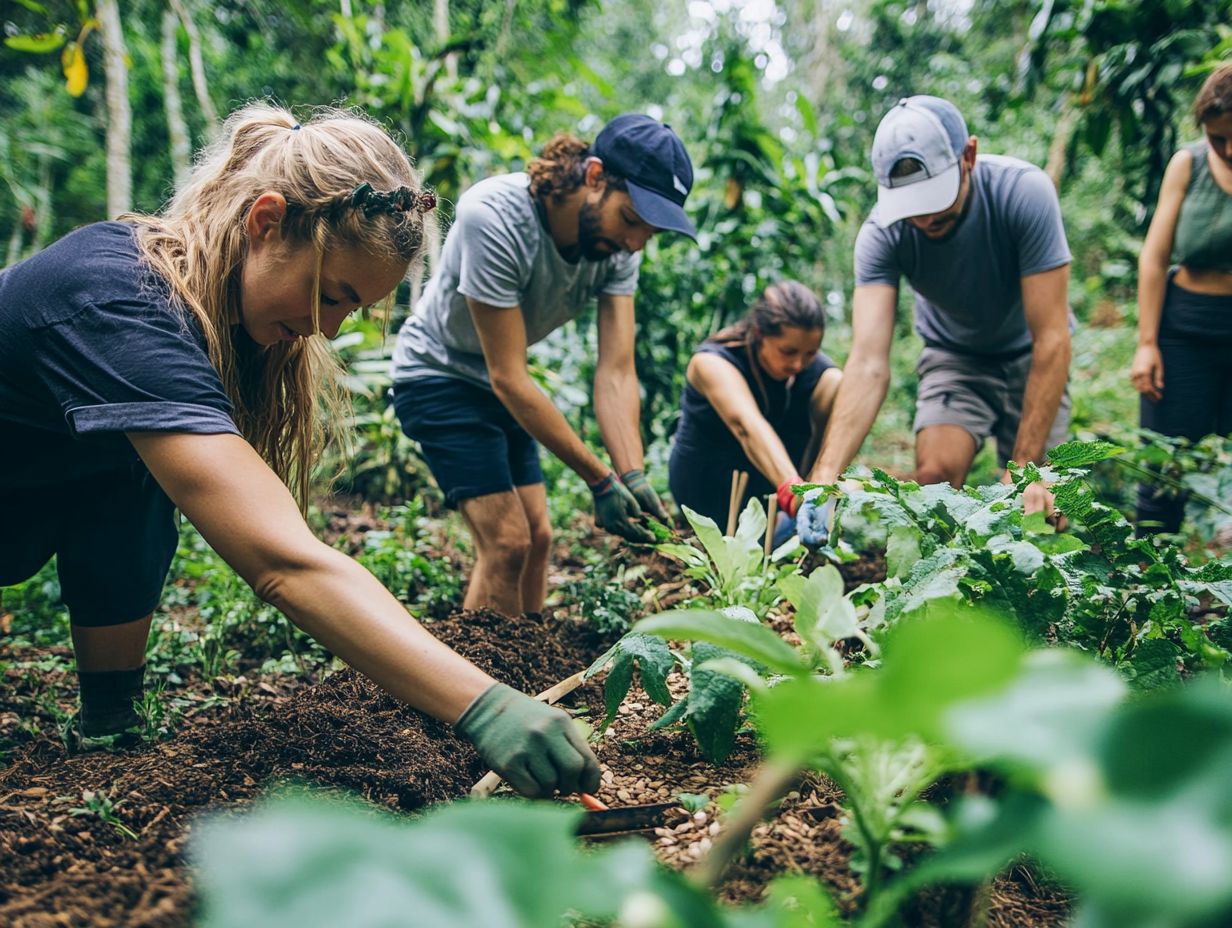
- Learn the principles of permaculture while gardening and farming, including the use of keyhole beds and mandala gardens.
- Use natural materials and composting workshops, such as mushroom compost and straw, for sustainable building.
- Promote community building and eco-friendly practices through skill sharing and DIY projects like creating a bug motel or engaging in nature therapy.
1. Gardening and Farming
Gardening and farming are essential for building sustainable communities and nurturing environmental education. Just look at initiatives like the Nature Kids Permaculture Club, where hands-on learning flourishes through practices like Permaculture gardening and the Zero Waste Challenge.
These practices also enhance your understanding of local ecosystems. They foster a strong sense of community and shared responsibility. Take community gardening projects, such as the community garden initiative, for example they offer a wonderful opportunity for neighbors to collaborate in cultivating edible plants while exchanging valuable tips on sustainable gardening techniques.
Participating in activities like edible weed walks and observing local animals not only raises awareness about local biodiversity but also emphasizes the ecological benefits of native plants.
These approaches improve not just dietary habits but also instill ecological behaviors that bolster community resilience. Engaging more deeply with food systems and the environment can lead to a significantly more sustainable future for everyone involved.
2. Composting Workshop
A composting workshop offers invaluable insights into sustainable practices. It invites you to grasp the significance of how materials move through the environment and discover how to create nutrient-rich soil through methods like mushroom composting.
Alongside mushroom composting, you ll encounter a variety of techniques, including traditional composting and worm composting. Each plays a crucial role in waste management. Traditional composting involves layering organic waste materials and regularly turning them to aerate, which accelerates the decomposition process.
Meanwhile, worm composting, or vermicomposting (a method of composting using worms to eat food scraps), employs earthworms to break down kitchen scraps and yard waste. This yields a highly nutrient-dense fertilizer while fostering community resilience.
Both approaches dramatically reduce landfill waste and enhance soil health. They are essential elements of environmental education and encourage you to conduct a personal audit. By engaging in these practices, you cultivate vital sustainability skills and deepen your understanding of your ecological impact.
Get involved in your community garden today! Join a composting workshop near you and explore these activities to be part of a thriving, sustainable community!
3. Seed Saving and Plant Propagation
Seed saving and plant propagation are essential for sustainable gardening. They allow you to grow a diverse array of garden varieties, including heritage varieties, while fostering ecological awareness and enhancing food security.
By mastering these techniques, you can help preserve heritage varieties that often have unique flavors and resilience. These varieties adapt well to local conditions through methods like soil layering, division, and cuttings.
Engaging in community initiatives boosts nature’s ability to recover. Participate in local seed swaps and workshops to enrich biodiversity and learn from others. This strengthens your connection to the ecosystem and promotes control over our food sources while discussing moon cycles and seasonal practices.
4. Building with Natural Materials
Get your creativity flowing by building with natural materials! Projects like keyhole beds, mandala gardens, and food forests enhance community resilience through eco-friendly crafts and shared knowledge.
Incorporating elements such as bamboo, straw bale, reclaimed wood, and natural stone minimizes your environmental footprint. Bamboo grows rapidly and is strong enough for fencing or structural components, while straw bales provide excellent insulation. Reclaimed wood adds character to projects and champions recycling, reducing the need for new materials.
Using natural stone in landscaping or pathways brings both durability and beauty. As you and your community collaborate to create these spaces, you build relationships, share skills, and deepen your connection to the environment all essential for sustainable living.
5. Cooking and Preserving Food
Cooking and preserving food elevate your culinary skills and play a vital role in community initiatives like seasonal festivals. At these gatherings, food blessings celebrate local harvests and encourage creative reflection.
Learn fun techniques like fermentation, which enhances flavor and extends shelf life, minimizing waste. Join us for popular canning workshops to master the art of preserving fruits and vegetables, forging a tangible connection between food and the local ecosystem.
Through these collaborative experiences, you will deepen your appreciation for traditional practices and foster a sense of belonging in your community. The blend of culinary arts and cultural traditions highlights the importance of respecting resources while embracing innovative approaches to food preservation.
6. Wildcrafting and Foraging
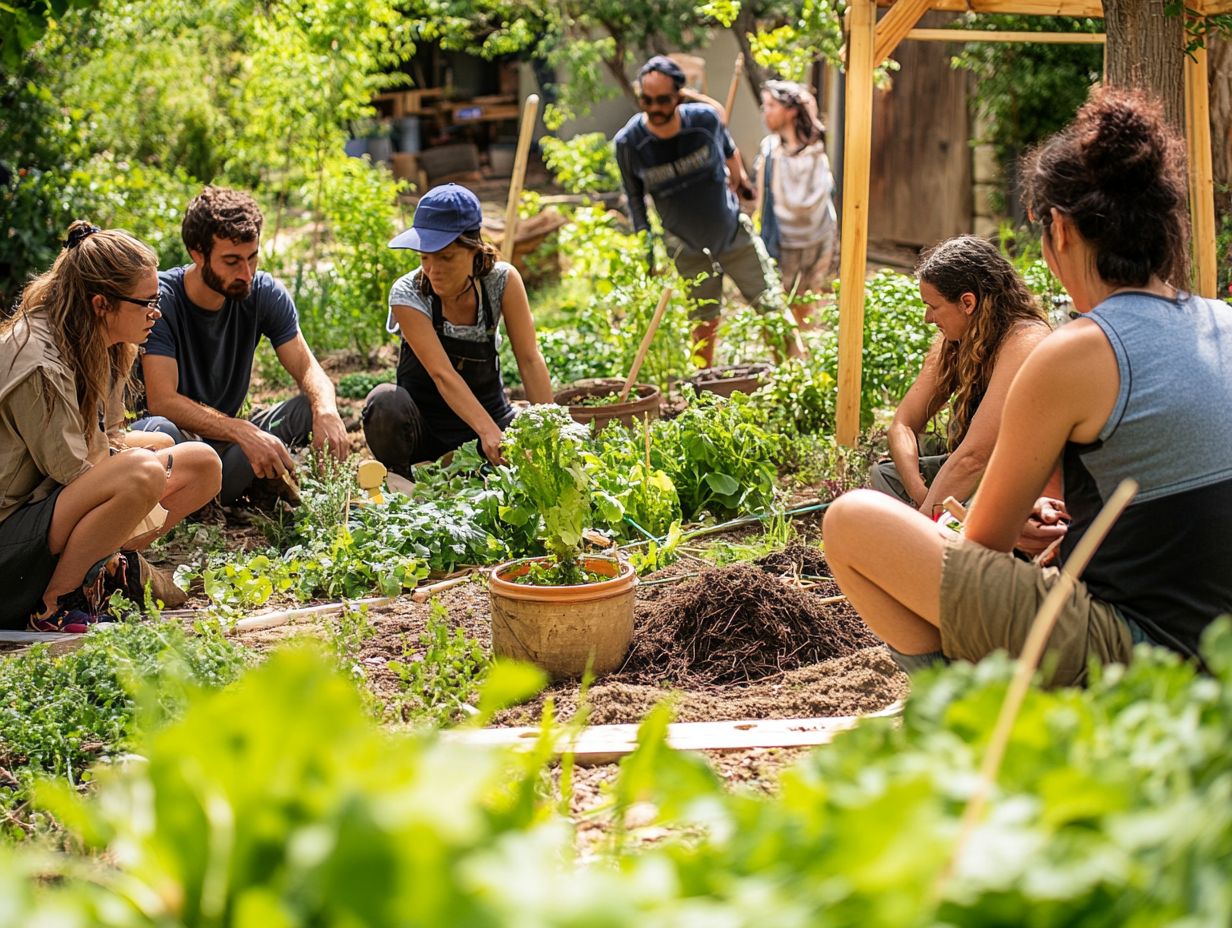
Wildcrafting and foraging offer you a unique gateway to connect with nature. This encourages caring for the environment while presenting opportunities for educational adventures that deepen your understanding of local flora and fauna.
You can also engage with local animals and practice nature therapy. Engaging in these activities helps you appreciate the environment and instills a sense of responsibility to preserve our precious ecosystems.
When you venture into foraging for edible plants, it’s essential to prioritize safety and ethics. Respecting natural habitats and adhering to sustainable harvesting guidelines is paramount. Familiarizing yourself with the local edible flora can elevate your experience and build a wealth of knowledge.
Many local initiatives and community groups, such as the Nature Kids Permaculture Club, offer workshops that teach the ethical practices of wildcrafting. These practices safeguard native species and ecosystems, enhancing your well-being and strengthening community bonds through shared experiences.
7. Creating a Permaculture Design
Creating a permaculture design offers you a holistic approach that maximizes resource flows. This cultivates sustainability skills within your community and encourages ecological behaviors and resilience.
Permaculture is a type of farming that works with nature to create sustainable systems. By embracing its principles, you can craft systems that work in harmony with nature rather than against it.
This design framework underscores the importance of observing local ecosystems, including moon cycles. This allows you to tailor solutions for your specific environment be it an urban garden or a sprawling rural farmland.
For example, a community in Portland transformed a vacant lot into a flourishing edible landscape with keyhole beds. This initiative enhanced food accessibility and promoted biodiversity, showcasing the power of permaculture.
A project in Australia showed how rainwater harvesting, swales, and fish-scale swales can effectively mitigate erosion while benefiting both agriculture and wildlife. These examples highlight that when communities thoughtfully apply these principles, they can cultivate lasting sustainable practices.
8. Nature Walks and Observation
Nature walks and observation are vital elements of outdoor education. They offer you the chance to engage in nature therapy and reflect on your ecological behaviors in an immersive learning setting.
Nature walks boost your mental well-being by alleviating stress and anxiety. They deepen your connection with the environment through creative reflection.
As you wander through diverse landscapes, you sharpen your observational skills, uncovering insights into local ecosystems and the intricate interdependencies that thrive within them.
This enriched understanding fosters appreciation for biodiversity and ignites your passion for conservation efforts. By engaging with nature firsthand, you are enabled to advocate for sustainable practices, making a positive impact in your community.
You’re helping to cultivate a culture of environmental stewardship.
9. Community Building and Skill Sharing
Community building and skill sharing are transformative processes that enable you to learn from one another. Take local leaders like Diana Condylas and Koa Windsong, for example; they excel at fostering collaboration in sustainability efforts.
These initiatives create vibrant hubs of knowledge where you and others can engage in workshops and collaborative projects. By providing opportunities for individuals to gather and share their skills, these community-driven efforts enhance your personal capabilities and strengthen social bonds.
Consider neighborhoods where local artisans and tradespeople lead hands-on workshops. Participants report a boost in confidence and a profound sense of belonging. The result is a more resilient community that adapts to challenges, demonstrating how skill-sharing activities nurture sustainability and cultivate a culture of cooperation.
10. Eco-Friendly Crafts and DIY Projects
Eco-friendly crafts and DIY projects do more than promote sustainability; they also strengthen community resilience by using creative teaching techniques that engage participants of all ages in hands-on learning.
These initiatives are exceptional tools for fostering collaboration and connection among community members. You can share ideas and resources while diving into exciting projects like:
- Upcycled bottle planters
- Natural dye workshops
- Communal garden installations
By getting involved in these activities, you develop critical skills such as teamwork and problem-solving, while gaining a deeper awareness of environmental issues.
This focus on creativity in education encourages you to think outside the box, paving the way for innovative solutions that embrace sustainability. You also enrich your understanding of local ecosystems and the impact of your actions.
What Is Permaculture and Why Is It Important?
Permaculture is a design method that seamlessly integrates land, resources, and community to forge resilient and self-sustaining ecosystems. It highlights the importance of ecological practices and community resilience in addressing environmental challenges.
Rooted in the wisdom of ancient agricultural traditions, this innovative approach emphasizes a harmonious relationship between human activity and the natural world. By keenly observing nature s dynamics, you can discover exciting ways to enhance biodiversity, minimize waste, and enrich soil fertility.
At its core, permaculture champions principles that maximize energy efficiency, promote local food production, and cultivate vibrant community networks. Its relevance is striking today, offering practical solutions to urgent issues like climate change, resource depletion, and urbanization.
Through hands-on applications such as backyard gardens, community farms, and agroforestry, permaculture nurtures the environment, revitalizes local economies, and fosters social equity.
How Can Permaculture Benefit the Environment and Society?
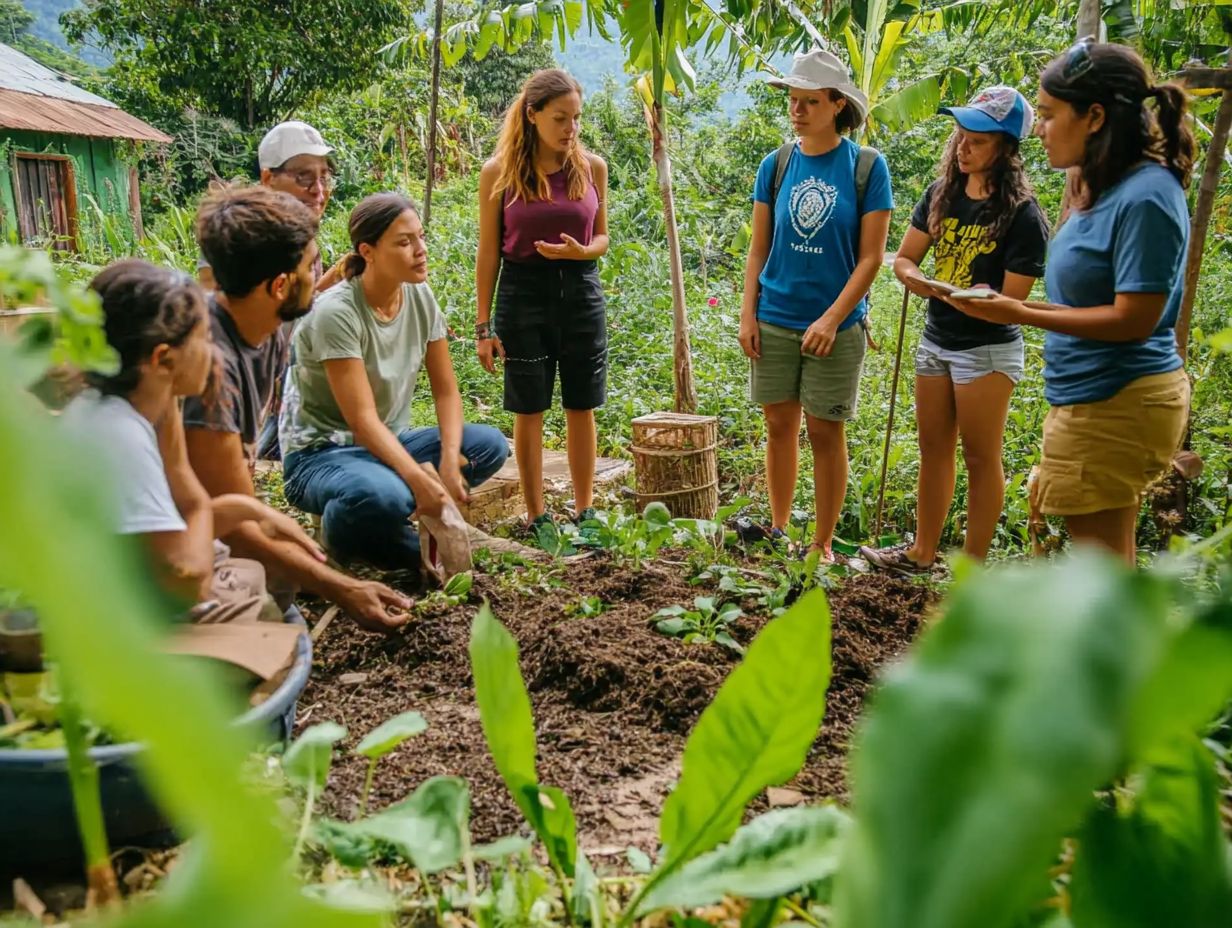
Permaculture provides a wealth of environmental and social benefits, such as enhanced biodiversity, improved soil health, and strengthened community resilience through shared sustainability skills.
These practices create habitats that nurture various species and promote responsible water management and carbon sequestration. For example, a community in Oregon successfully implemented permaculture techniques, resulting in a remarkable 30% increase in native plant species and a significant reduction in soil erosion. This initiative revitalized the local ecosystem and fostered social connections as residents collaborated on workshops, exchanging knowledge about organic farming and foraging.
In another instance, a permaculture project in the Philippines played a crucial role in stabilizing food security after natural disasters, illustrating the powerful synergy between ecological health and community well-being. These examples highlight how permaculture transforms environments and reinforces social structures, ultimately leading to the creation of sustainable communities.
What Are the Key Principles of Permaculture?
The key ideas of permaculture focus on working in harmony with nature, integrating systems, and fostering diversity to cultivate sustainable and productive environments.
By emphasizing this balance between your needs and the natural world, these ideas guide you in designing ecosystems that can flourish over time. For instance, in your backyard garden, you might consider companion planting growing certain plants together to boost growth and naturally fend off pests.
In community settings, permaculture can take shape through urban gardening initiatives that transform underutilized spaces into vibrant green areas, enhancing food security and biodiversity. Techniques like rainwater harvesting (collecting rainwater for use) and composting (breaking down organic waste into nutrient-rich soil) demonstrate how these ideas can significantly improve resource efficiency, contributing to overall resilience and reducing reliance on external inputs.
How Can Permaculture Be Applied in Urban Areas?
In urban areas, you can effectively harness permaculture through initiatives like community gardens, rooftop farms, and vertical planting, fostering sustainability and ecological awareness in densely populated spaces.
These projects offer fresh produce and create lush green oases amidst the concrete jungle, enhancing biodiversity and improving air quality. By integrating these ideas, you can cultivate your own food, reduce your reliance on transportation, and even build a sense of community.
Picture this: transforming dull vacant lots into lush, vibrant gardens! Imagine engaging residents and encouraging them to take ownership of their surroundings. Urban permaculture addresses food insecurity while promoting social interactions, enabling individuals to collaborate on shared goals. This revitalizes neighborhoods and instills a sense of pride and connection among community members.
What Are Some Common Challenges in Permaculture and How Can They Be Overcome?
You may encounter common challenges in permaculture, such as soil health, water management, and community engagement, but rest assured that innovative solutions and collaborative efforts can help you overcome these hurdles and build community resilience.
These challenges often arise from limited access to resources, varying levels of expertise among practitioners, and the necessity for effective communication. To improve soil health, for example, you can implement regenerative practices like cover cropping (growing specific plants to enhance soil health) and composting, which can significantly enhance both soil structure and nutrient availability.
In terms of water management, consider utilizing techniques such as rainwater harvesting or constructing shallow trenches designed to manage water runoff. By fostering community networks, you not only facilitate the sharing of knowledge and resources but also create a supportive environment where stakeholders can work together to tackle these issues, ensuring the sustainability and success of your permaculture initiatives.
How Can Permaculture Groups Make a Positive Impact in Their Community?
Permaculture groups have the power to make a real difference in their communities by promoting essential sustainability skills, organizing educational events, and sharing inspiring success stories through local newspapers.
Along with these efforts, you ll often find them hosting hands-on workshops that allow community members to dive into gardening techniques, soil regeneration, and water conservation strategies. Take, for example, a recent initiative that transformed vacant lots into vibrant community gardens. This project not only boosted local food production but also strengthened neighborhood connections.
Many groups have also kicked off seed exchanges and composting drives, encouraging sustainable practices right at home. These initiatives raise environmental awareness and spark greater participation in community projects, enabling individuals like you to take charge of local ecosystems and cultivate a more resilient future!
What Are Some Tips for Hosting a Successful Permaculture Activity?
Hosting a successful permaculture activity is an exciting opportunity to engage your community! It requires careful planning, community involvement, and environmentally friendly practices that resonate with participants.
Start by selecting topics that address local environmental issues. This fosters a deeper connection to the subject matter.
Consider logistics, such as venue accessibility, materials, and timing. These factors ensure everything is arranged for a seamless experience.
Captivate participants by incorporating interactive elements like hands-on activities or group discussions. Gathering feedback after the event is essential for understanding what worked and what can be improved, nurturing a culture of continuous enhancement for future activities.
Frequently Asked Questions
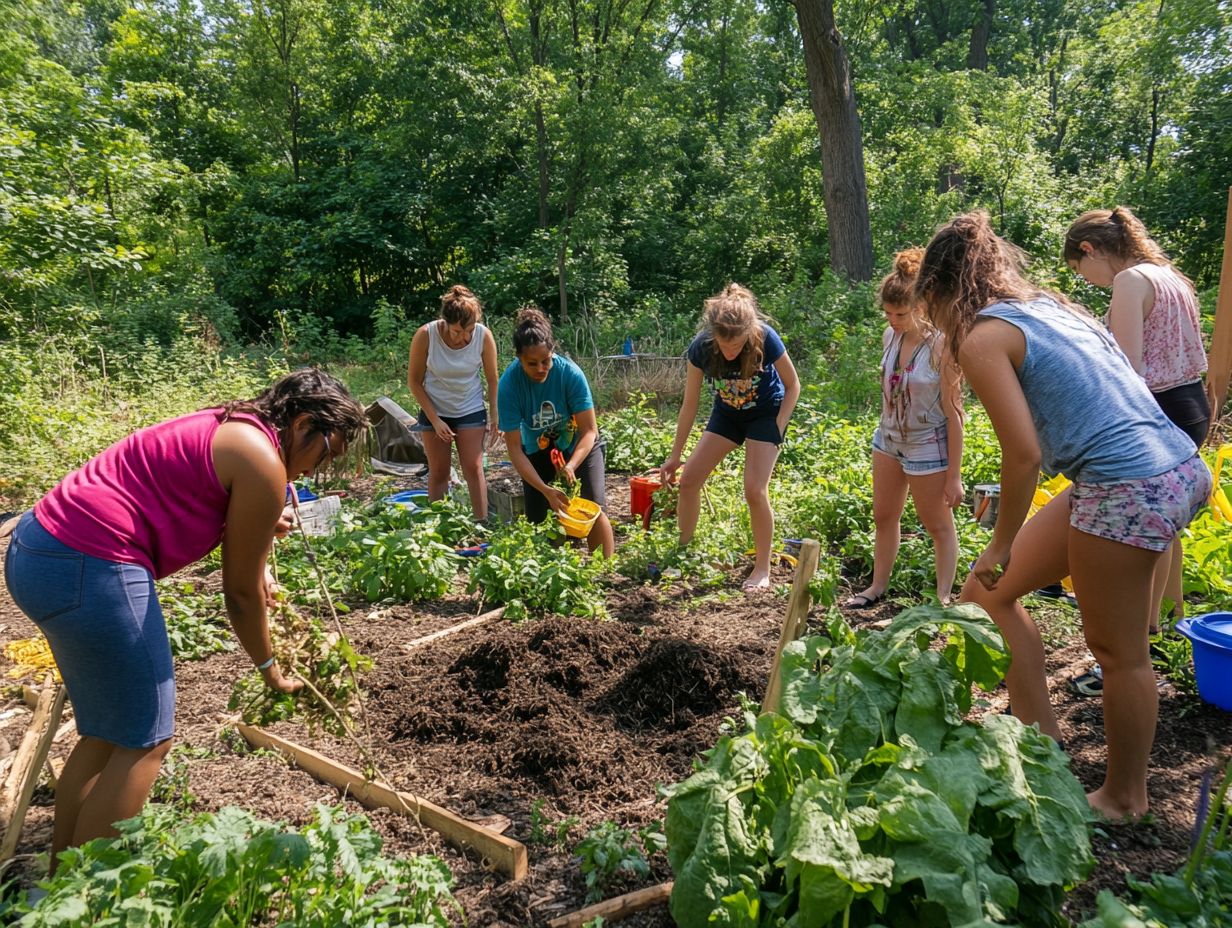
What are some fun activities for permaculture groups?
Some fun activities for permaculture groups include community gardening, seed swapping, composting workshops, and nature walks.
How can community gardening benefit a permaculture group?
Community gardening can benefit a permaculture group by promoting teamwork, teaching sustainable gardening practices, and providing a way to share resources and knowledge.
What is seed swapping and why is it a great activity for permaculture groups?
Seed swapping is the exchange of seeds between gardeners, allowing for a diverse variety of seeds to be shared and grown. It is a great activity for permaculture groups as it promotes biodiversity and helps preserve heirloom and rare plant species.
Why are composting workshops important for permaculture groups?
Composting workshops can teach permaculture groups how to turn organic waste into nutrient-rich soil for their gardens. This promotes sustainability and reduces the need for chemical fertilizers.
What can nature walks offer for permaculture groups?
Nature walks provide permaculture groups with a chance to observe and learn about local flora and fauna, as well as see examples of permaculture principles in action in a natural setting.
How can permaculture groups incorporate fun activities into their meetings?
Permaculture groups can incorporate fun activities into their meetings by planning potluck dinners, film screenings, guest speaker events, and hands-on workshops such as making natural cleaning products or building a rain barrel.

